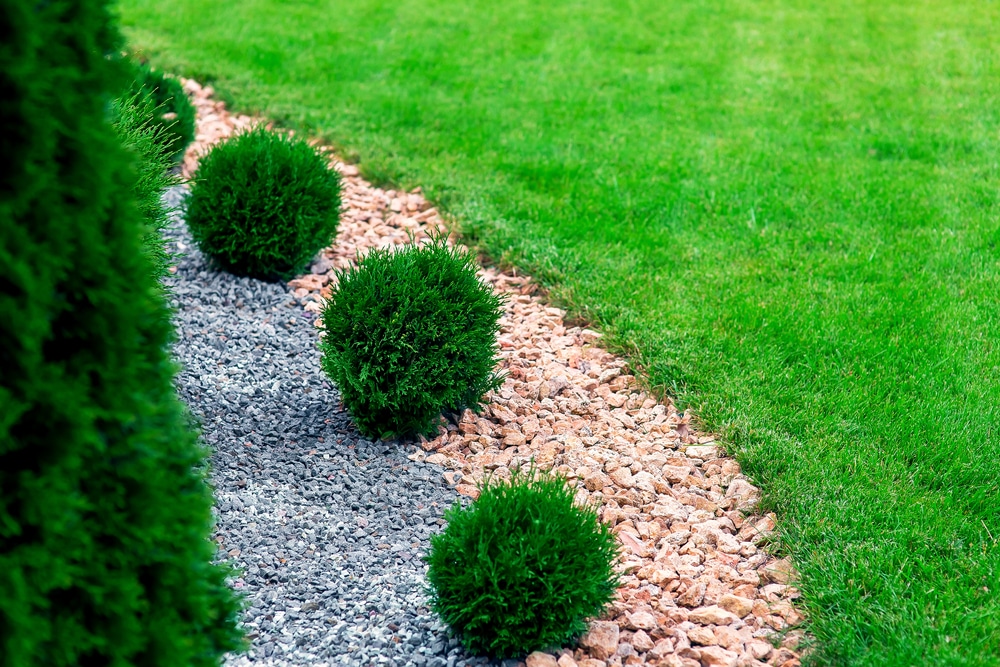There are certain materials that are known for their versatility as landscaping products, and one of the single best examples here is gravel. If you visited five different landscape designs right now, you’d be liable to find five completely different uses of gravel – that’s part of what makes it such a great material!
At BioGrass Sod Farms, we’re happy to offer a wide range of landscape hardgoods that includes gravel, rock, cobble, mulch, bark and more. We’ve assisted countless clients with all their gravel needs, including those who are looking for some inspiration on how to use this versatile material within their landscape setup. Here are some of the top approaches or combinations where gravel is often found in landscapes, plus some tips on how to achieve each of them.
As a Patio or Walkway Material
One of the most common uses of gravel is as a patio or walkway material. This setup is perfect for those who want an elegant and unique look without the hassle of having to actually build something. Simply add some solid edging around your space, fill it in with gravel, and you’re ready to go!
There are several kinds of gravel that may be useful for this purpose. Larger, more angular gravels will give you a more traditional look, while softer rounded stones can also make for a beautiful addition to your patio or walkway. To ensure that the surface remains level and stable, it’s important to spread the gravel in even layers and tamp them down with a hand tamper or plate compactor.
In addition, it’s important to think about the colors of the gravel you’re using. Warmer colors, like red and brown, are great for creating a cozy atmosphere. Meanwhile cooler colors such as blue and green can create an interesting contrast to the other elements in your landscape design.
As Drainage Material
Gravel is also useful for drainage purposes, particularly where small amounts of water are running over a surface. This is because gravel helps to slow down the flow of water, allowing it to penetrate into the soil beneath instead of pooling on the surface.
For instance, plant beds and flower beds often contain gravel at the bottom in order to help ensure that the plants are receiving enough water without the risk of standing water or pooling. As a general rule, you should use coarse gravel with large particles, as this will allow for better drainage.
Gravel Paired With Stone
Whether for walkways or various other landscape elements, pairing rock and gravel together can create a great effect. The combination of materials results in a distinct textural contrast that often looks quite stunning.
For example, the use of artificial stone with light-colored gravel can create an outdoor space that looks like it came right out of a fairytale! When combining these two materials, be sure to use light-colored gravel and darker stones, as this will help create a pleasing visual contrast that can really make your landscape stand out.
Gravel and Fire Pits
Another great way to use gravel within a landscape setup is for fire pits. Gravel can be used to create a border around the perimeter of the fire pit, helping to keep it contained and safely separated from other elements in your yard. This will also help protect the surrounding area from heat damage while still allowing you to enjoy some nice warmth on those chilly nights.
When using gravel for a fire pit, be sure to select larger pieces that are less likely to get kicked out of the area. You should also avoid using light-colored gravels in this application, as they are more prone to discoloring from the heat of the fire.
Erosion Control
While we already talked about basic drainage above, gravel can also be used for larger scale erosion control. This is particularly true in areas that are prone to heavy rains or runoff, such as hillsides.
In these cases, gravel can be spread evenly across a hillside in order to create an effective barrier against the force of water, helping to slow it down and prevent soil loss. Larger pieces of gravel are usually the best option for this application, as they will have more effective interlocking capabilities.
Weed Suppression
In still other cases, gravel may be used to help suppress weeds. By adding a layer of gravel over soil, you can drastically reduce the likelihood of weed growth as they will not have enough nutrients or water to thrive in such an environment.
This makes it a great option for garden paths and other areas where weeds are known to be a problem. To get the best weed-suppressing capabilities from gravel, use a finer type such as pea gravel.
In conclusion, there are plenty of ways to make use of gravel in your landscaping design. From protecting against erosion to providing an interesting contrast between different elements, it can be used for a variety of purposes. With the right knowledge and creativity, you can use gravel to create a truly stunning landscape that will be the envy of all your neighbors!
And at BioGrass Sod Farms, we’re here to help you find the perfect gravel for any landscaping project. With our expert advice and unbeatable selection, you’ll be able to find exactly what you need for a beautiful landscape design that will last for years to come. Contact us today to learn more!
